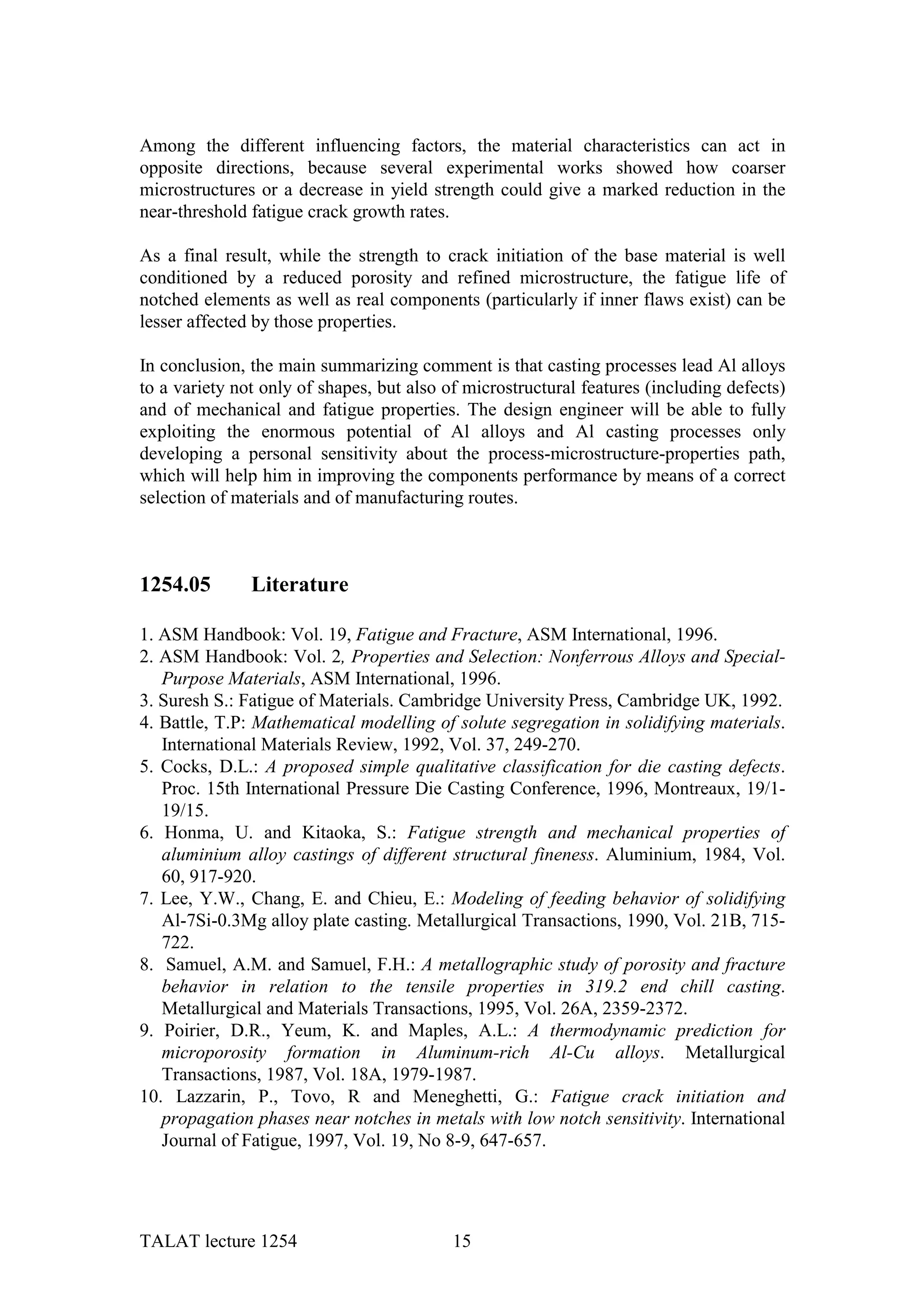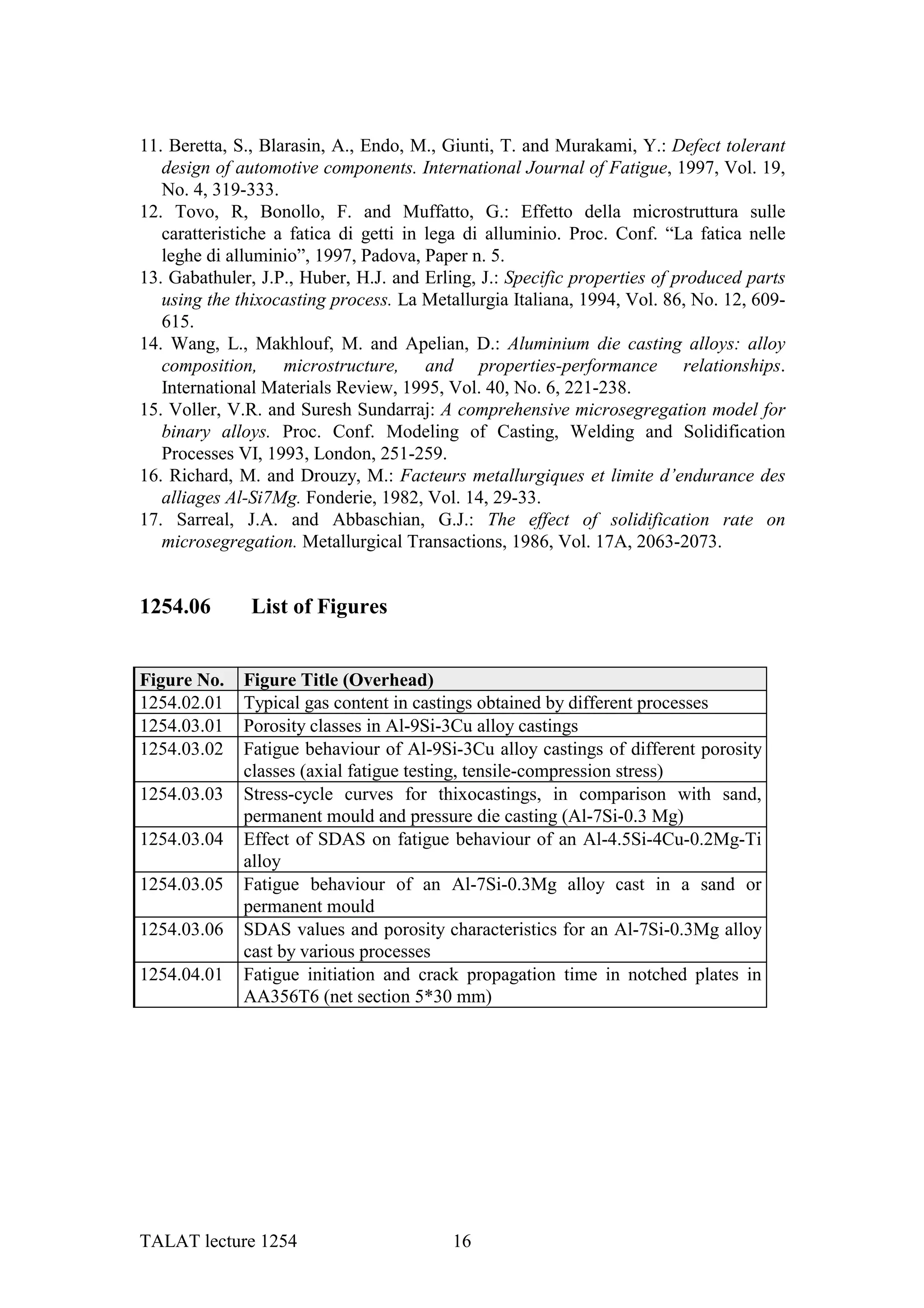The document discusses the fatigue behavior of aluminum casting alloys, emphasizing the correlation between foundry processes, microstructure, and defects. It explains how various casting methods impact the thermal parameters and microstructural features that ultimately affect the fatigue performance of the alloys. A focus is placed on minimizing porosity and optimizing dendrite spacing to improve mechanical properties and fatigue resistance.
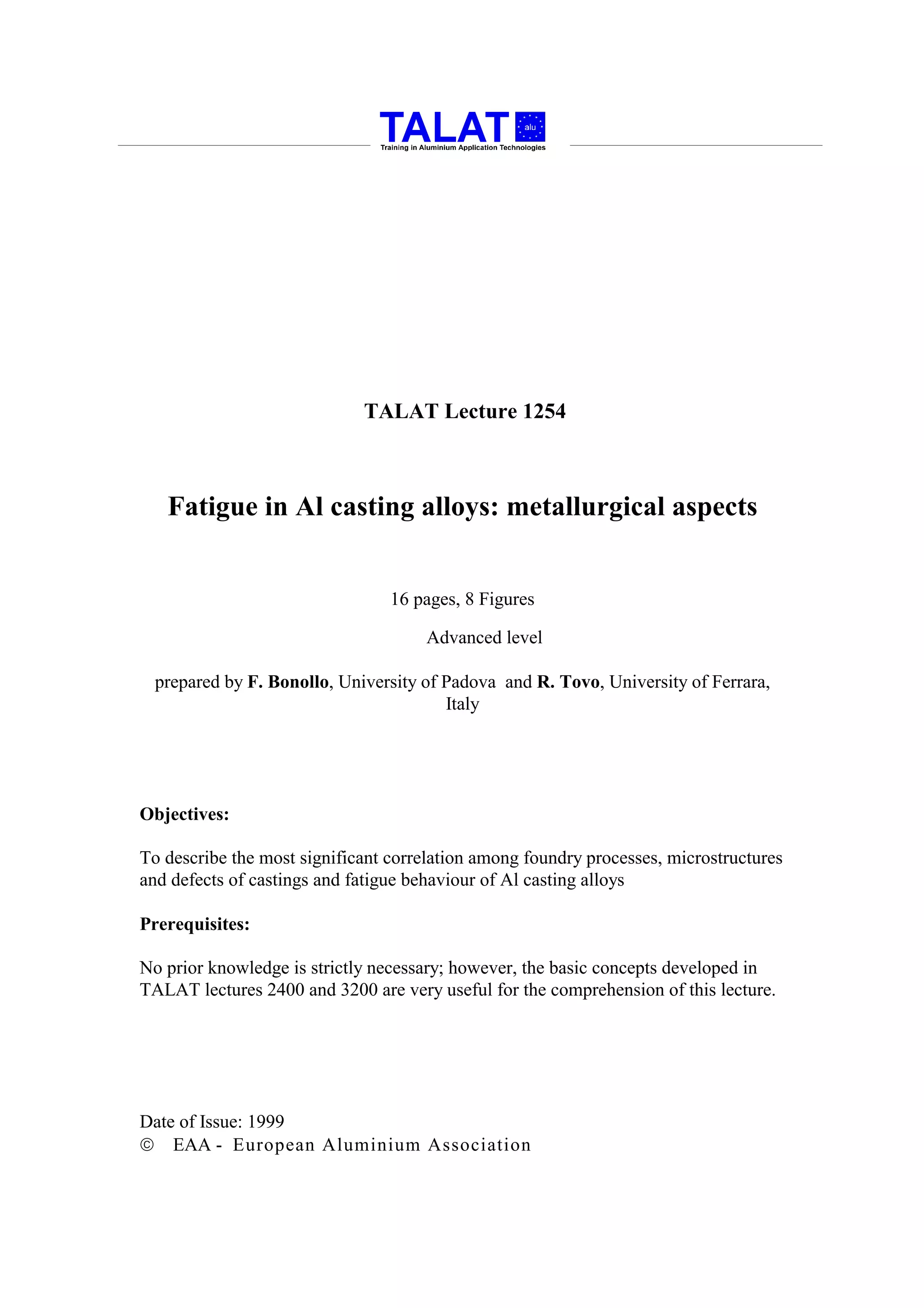
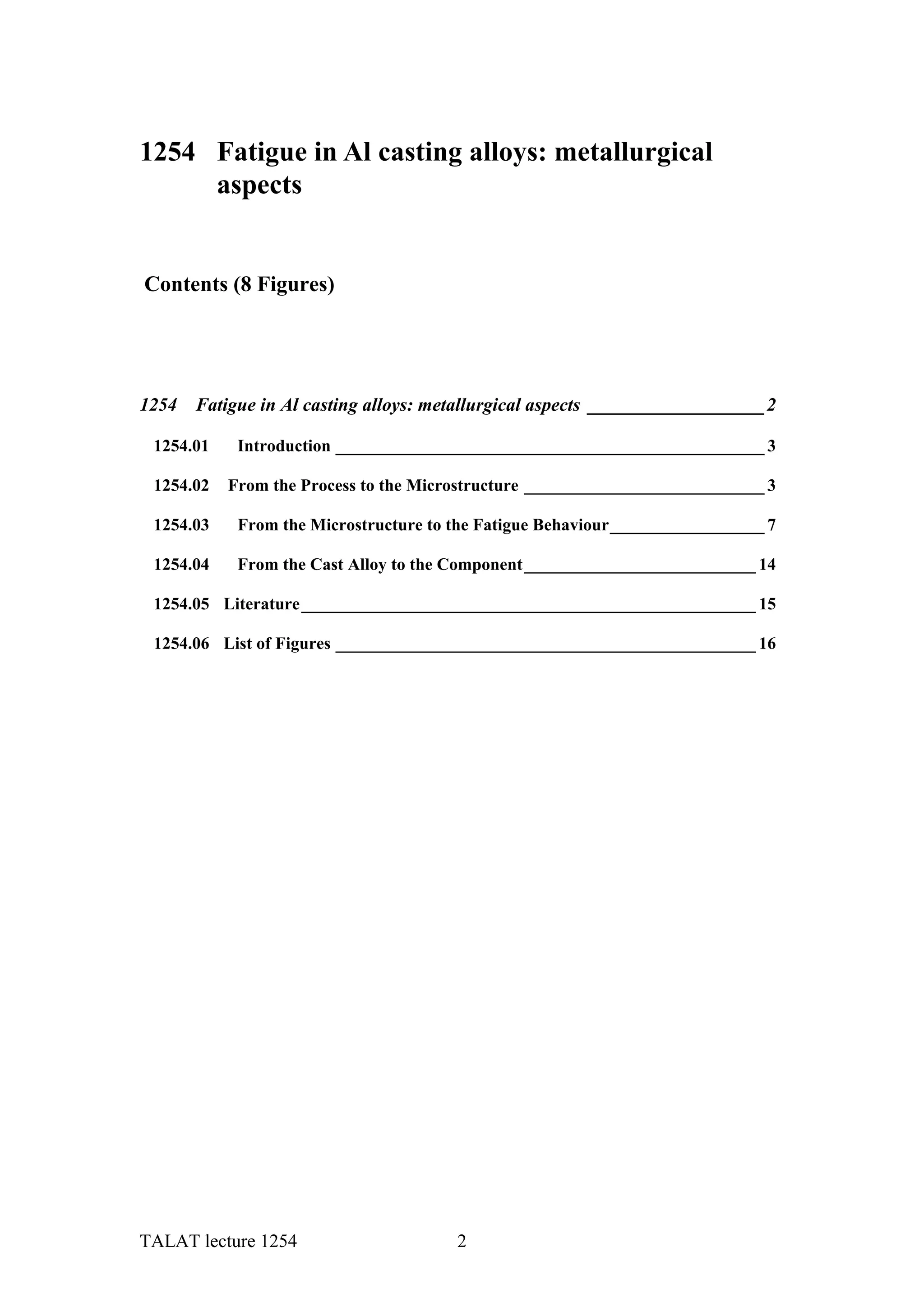
![1254.01 Introduction
The design relevance of fatigue phenomena is certainly well-known, and it has been
widely reviewed in the TALAT lecture 2400. The most important and used wrought
alloys are presented there, describing their fatigue behaviour as the result of
microstructural aspects, heat treatments and manufacturing processes (welding,
bolting, and so on).
Due to their increasing relevance in various industrial applications, well documented
by market studies, it seems interesting and useful to review the fatigue behaviour of Al
casting alloys. Generally speaking, such a behaviour is affected by a lot of variables:
the role of some of them (heat treatment, presence of inclusions) is the same as in
wrought alloys (and it has been already described in TALAT lecture 2400). There are,
however, other variables which are peculiar for cast alloys and decisive in determining
the fatigue performance of castings. For studying them, it is necessary to consider that
- the fatigue characteristics of Al casting alloys are strongly related to their
microstructural features,
- such features are the result of the processing conditions imposed to the alloys,
- there is a strong development in terms of new casting processes, to improve the
quality and the performances of Al cast components.
The process-microstructure-properties path needs to be followed, in order to fully
understand the fatigue behaviour of Al casting alloys.
1254.02 From the Process to the Microstructure
The casting processes industrially available for Al alloys are several, and their number
is continuously increasing. TALAT lecture 3200 gives an overview of the most
common as well as of the newer casting processes. The more useful way for
classifying such processes is based on the characteristics of thermal field they impose
on the alloy. This means that parameters such as cooling rate [K/s] and thermal
gradient [K/mm] are good indexes of the evolution of the process. Table 1 lists the
typical thermal parameters induced by different conventional processes.
Cooling Thermal
Process rate gradient
[K/s] [K/mm]
Gravity - dry sand 0.05-0.20 0.05
Gravity - green sand 0.1-0.5 0.05
Gravity - permanent mold 0.3-1.0 n.a.
Die Casting 1.0-3.0 n.a.
DC casting 0.5-2.0 0.3
Chill casting 10-15 0.3-5.0
Directional solidification 0.2-4.0 10
Table 1: Typical values of thermal parameters for various casting processes
TALAT lecture 1254 3](https://image.slidesharecdn.com/talat-lecture-1254-fatigue351/75/TALAT-Lecture-1254-Fatigue-3-2048.jpg)

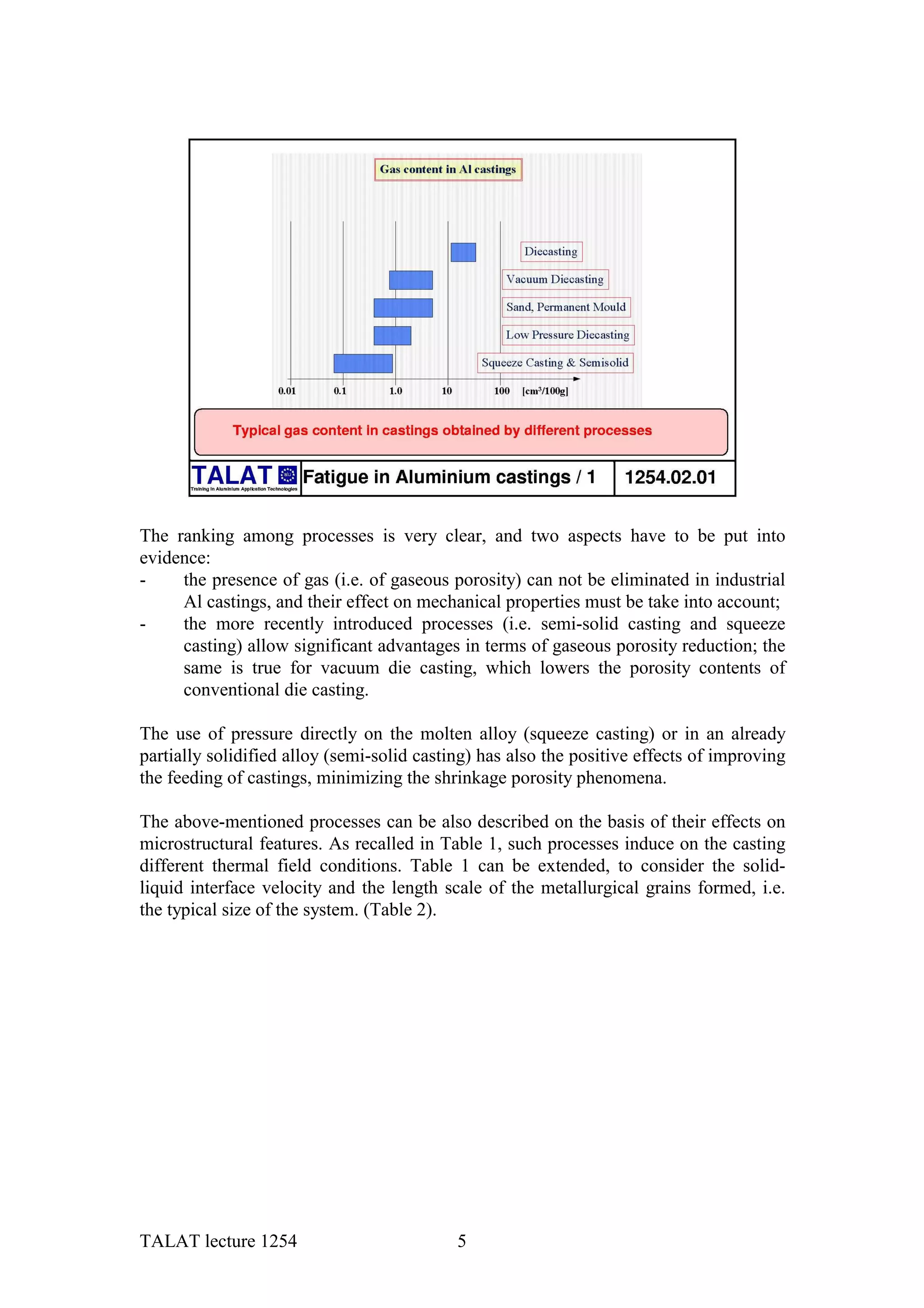
![Cooling Thermal Interface Length
Process rate gradient velocity Scale
[K/s] [K/mm] [mm/s] [mm]
Gravity – dry sand 0.05-0.20 0.05 2.0 0.10-1.00
Gravity – green sand 0.1-0.5 0.05 6.0 0.05-0.10
Gravity – permanent mold 0.3-1.0 n.a. n.a. 0.03-0.07
Die Casting 1.0-3.0 n.a. n.a. 0.02-0.07
DC casting 0.5-2.0 0.3 2 0.03-0.07
Chill casting 10-15 0.3-5.0 0.2-2.6 0.01-0.10
Directional solidification 0.2-4.0 10 0.1-0.001 0.03-0.04
Table 2: Typical values of thermal and microstructural parameters for various casting
processes
More generally, it has been demonstrated (see also Lecture 3200), that two important
quantitative microstructural parameters, the primary dendrite arm spacing (d1) and the
secondary dendrite arm spacing (SDAS, d2) can be related to the thermal field derived
parameters:
a b
d1 = A GL R (1)
n
d2 = C ts (2)
where GL is the thermal gradient in the liquid in front of dendrites, R is the interface
velocity, ts is the solidification time (which can be evaluated as the ratio between the
liquidus-solidus temperature interval and the cooling rate during solidification), A, a,
b, C and n are constants (related to the alloys).
The SDAS parameter is certainly the most commonly used: it increases as the cooling
rate decreases: processes having a high heat removal capability give place to finer
microstructures.
Finally, another microstructural aspect have to be considered: as the cooling rate
induced by a process on an Al alloy increases, the “distance” from the equilibrium
conditions described by phase diagrams increases, due to segregation phenomena (see
Lecture 3200, with the different hypotheses on which the lever rule and the Scheil
equation are based), leading to inhomogeneous composition profiles on primary
dendrites and to the amounts of eutectic phases different from thermodynamics
prediction. The following Table 3 gives an interesting example (obtained by means of
directional solidification processes) of this behaviour.
TALAT lecture 1254 6](https://image.slidesharecdn.com/talat-lecture-1254-fatigue351/75/TALAT-Lecture-1254-Fatigue-6-2048.jpg)
![Al-4.9%Cu Cooling Thermal Interface wt%
alloy rate gradient velocity Eutectic
[K/s] [K/mm] [mm/s]
0.1 10 0.01 7.12
1.05 10.5 0.10 8.34
11.25 7.5 1.5 8.75
65 13 5.0 9.14
187 19 10 9.57
Table 3: Effect of cooling rate and thermal gradient on microstructural features for an
Al-4.9% alloy
1254.03 From the Microstructure to the Fatigue Behaviour
The path from processes to microstructure and defects of casting has been described in
the previous paragraph. Generally, microstructure and defects affect the mechanical
behaviour of Al casting alloys.
The section reduction effect of porosity, as well as the stress intensification effect of
porosity and/or inclusions is obvious when the static behaviour is considered. It is also
well-known that a fine grain size usually improves mechanical properties. For Al
casting alloys this is expressed by means of correlations between SDAS and UTS, YS
and elongation, of the kind:
y = a’ d2n’ (3)
where y is UTS, YS or elongation and a’, n’ are alloy-related constants. Strictly
speaking, these correlations are true under the assumption of constant porosity level
into the alloy. In other words, attention must be devoted to the overimposing effects of
porosity and grain size/SDAS. Let’s consider the following Table 4, achieved from
end chill casting experiments on an Al-6Si-4Cu-0.5Fe alloy (the Hydrogen level was
less than 0.1 cm3/100g Al, due to an Ar degassing operation). Even in this case, where
finer grain size are associated to more reduced porosity amounts, there are
contradictory results among UTS and YS.
TALAT lecture 1254 7](https://image.slidesharecdn.com/talat-lecture-1254-fatigue351/75/TALAT-Lecture-1254-Fatigue-7-2048.jpg)
![Distance
from Average Grain Porosity UTS YS e
chill end SDAS size [%vol] [MPa] [MPa] [%]
[mm] [µm] [µm]
5 17 650 0.014 234 131 4.5
20 48 950 0.024 214 141 1.7
40 70 1100 0.212 192 141 1.1
100 93 1200 0.505 162 142 0.4
Table 4: Changes in microstructural parameters and in mechanical properties as
functions of the distance from chill end
Going to the topic of this lecture, the SDAS and the amount and size of porosity are
considered as the most important metallurgical parameters affecting the fatigue
behaviour of Al casting alloys.
The effect of porosity (which, as shown, is an unavoidable component of castings) on
fatigue is certainly complex.
Some simplified approaches tend to consider only the amount of porosity, identifying
some classes in terms volume percent of voids. For an Al-9Si-3Cu alloy, 5 porosity
classes have been individuated (Figure 1254.03.01). The data of axial fatigue tests are
given in Figure 1254.03.02, showing the detrimental role of relevant porosity
amounts.
The consequence is clear: porosity has to be minimised; this is the goal of innovative
foundry processes for Al alloys. If a comparison is carried out among semisolid
casting and more conventional processes, the fatigue behaviour of the semisolid cast
alloys is significantly better, due to the strong reduction of porosity which is assured.
TALAT lecture 1254 8](https://image.slidesharecdn.com/talat-lecture-1254-fatigue351/75/TALAT-Lecture-1254-Fatigue-8-2048.jpg)
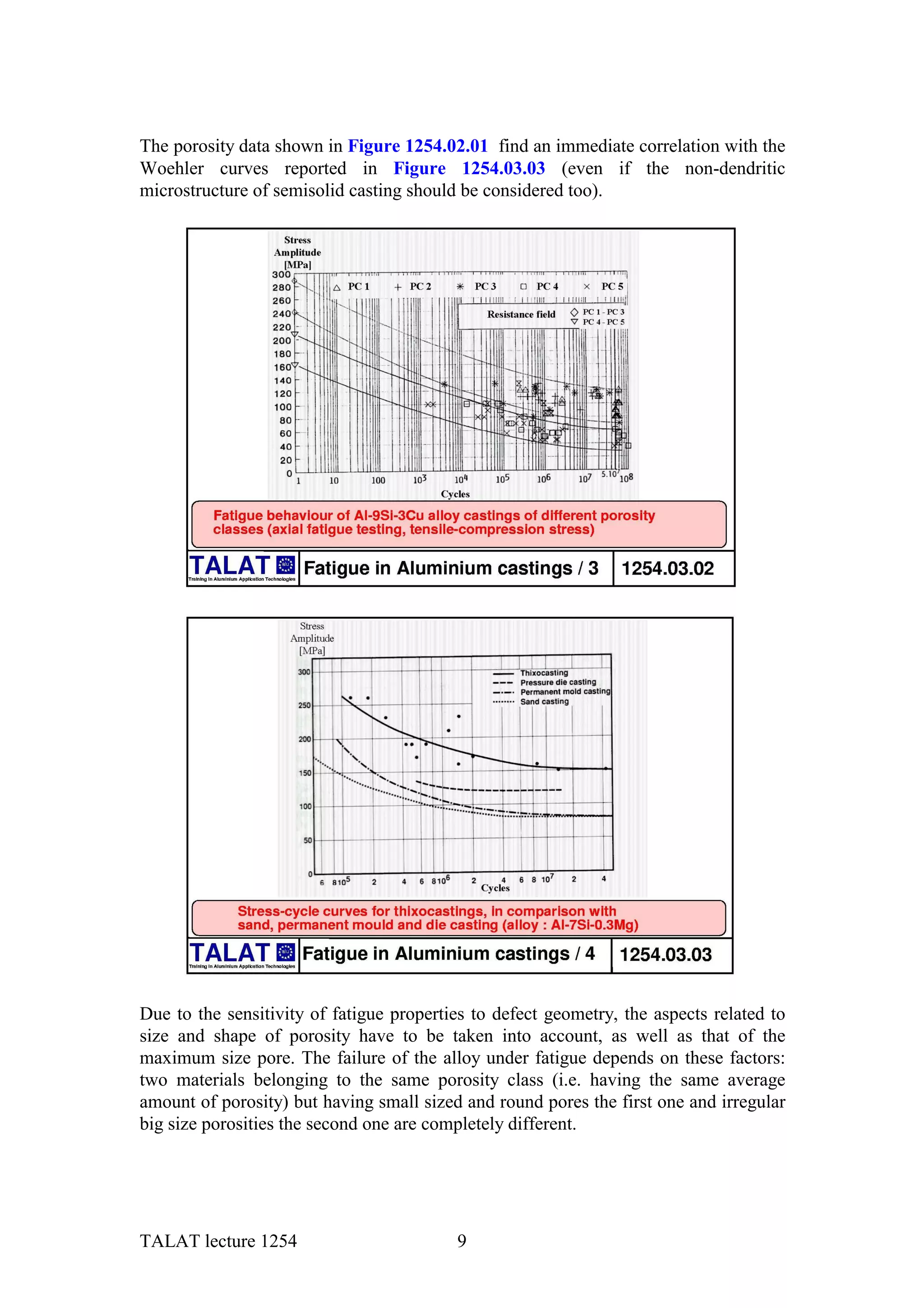
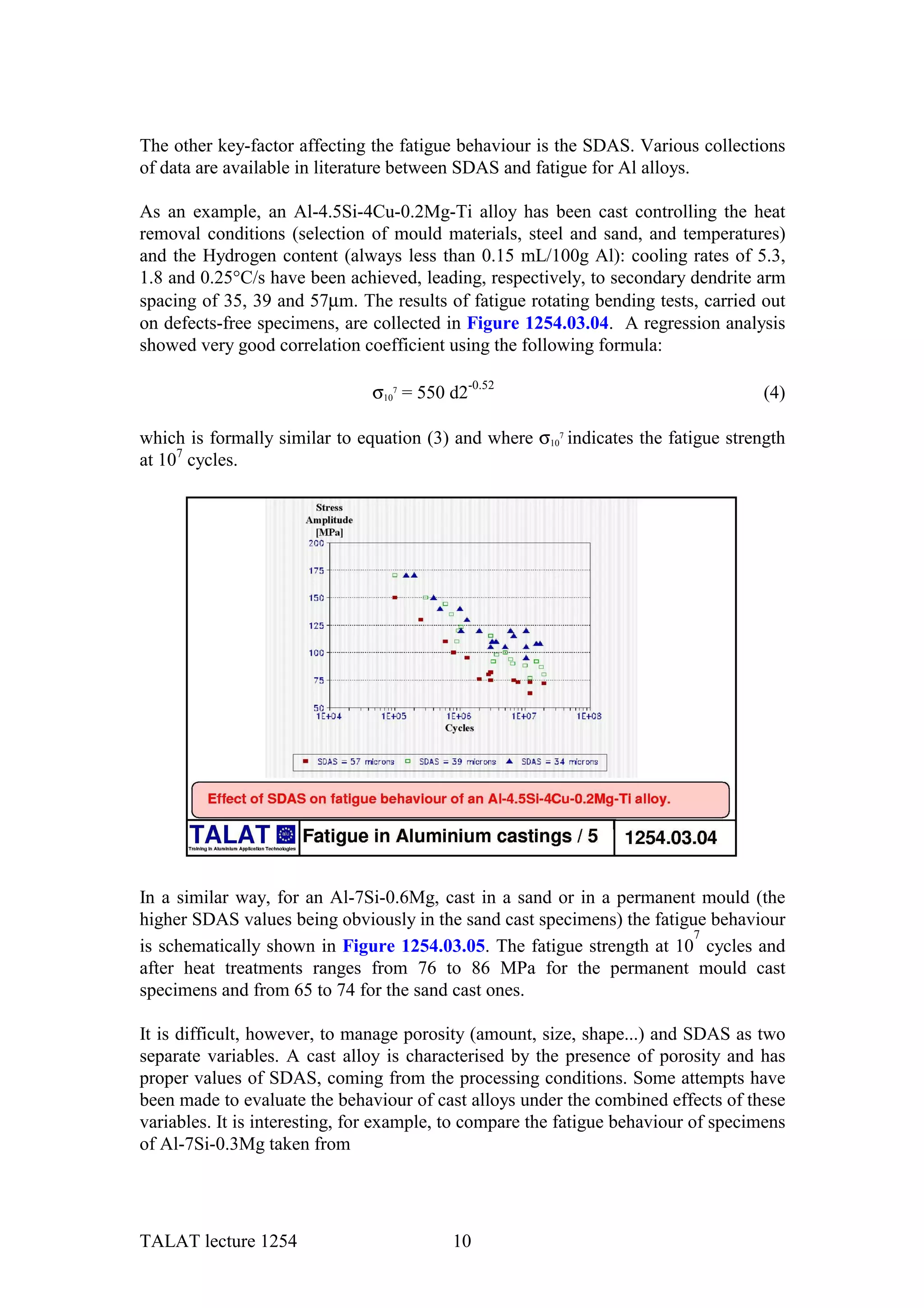
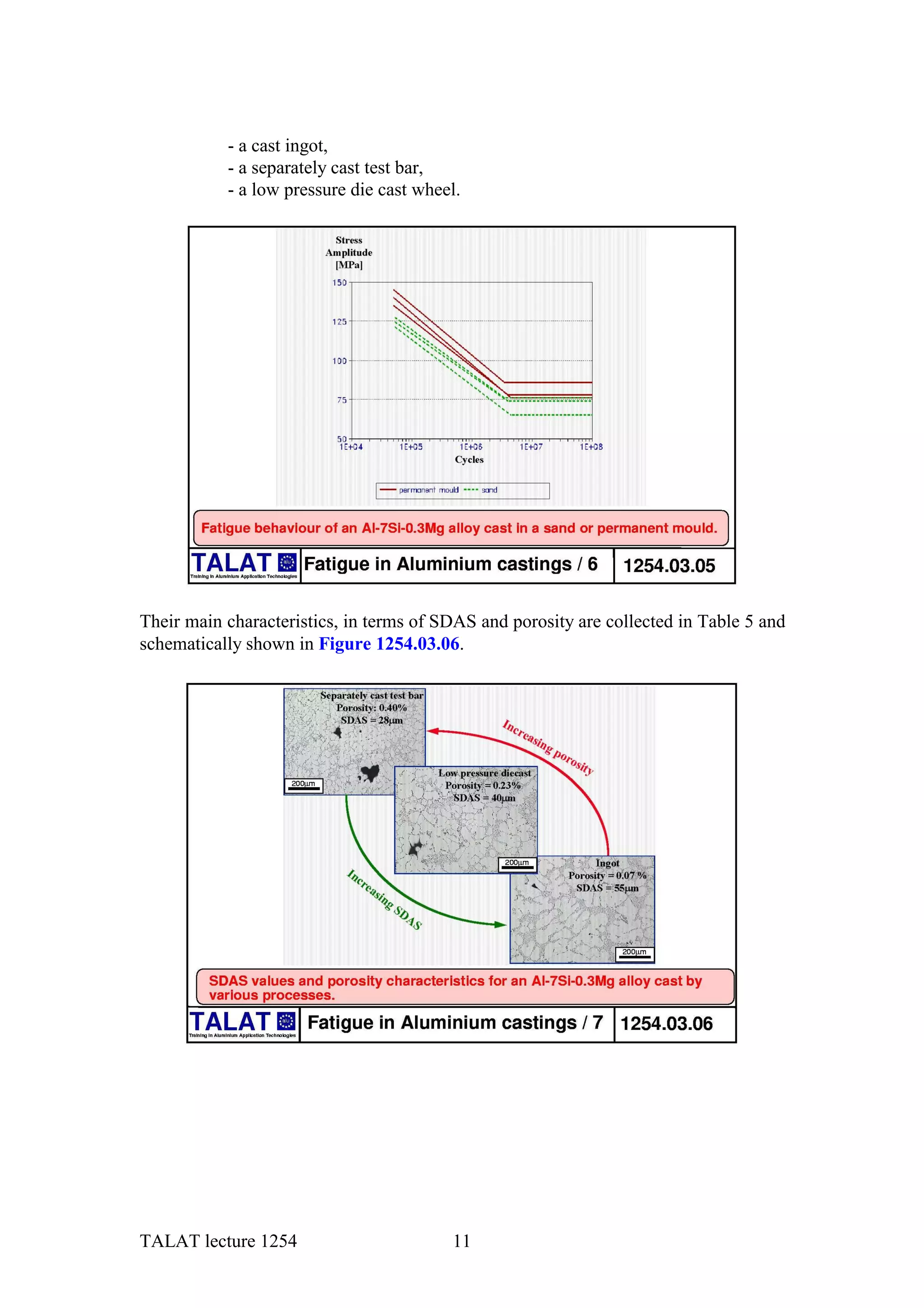
![Material SDAS porosity porosity maximum pore size maximum
[µm] [%vol] class pore size class pore area
(PC) [µm] (SC) [µm2]
Ingot 55 0.07 0a 57 0 1350
test bar 28 0.40 0b 216 2 15270
l.p. wheel 40 0.23 0b 136 1 2720
Porosity class (PC) = 0a Porosity < 0.15%
= 0b Porosity ranging from 0.16% to 1.0%
Pore size class (SC) = 0 Maximum pore size < 100µm
1 Maximum pore size ranging from 101 to 200 µm
2 Maximum pore size > 200 µm
Table 5: SDAS values and porosity characteristics (amount, maximum pore size and
area) for an Al-7Si-0.3Mg alloy cast by various processes
The higher values of SDAS are, as expected, in the cast ingot, the lower ones are in
the separately cast (in a permanent mould) test bar. On the other side, the ingot shows,
in terms of both %vol and size, minimum porosity; the separately cast test bar and the
specimens from the wheels fall in the same porosity class, while the test bar presents
big sized pores.
Such specimens, after a T6 heat treatment, showed the fatigue behaviour summarized
in Table 6, adopting the Woehler curve model:
σ50% = σ50%, 2 000 000 (N/2 000 000)-1/k (5)
where σ50% = average fatigue strength, σ50%, 2 000 000 = average fatigue strength at 2
millions of cycles, N = number of cycles, k = exponent of the Woehler curve.
material σ50%, 100 000 k σ50%, 2 000 000
[MPa] [MPa]
ingot 192 7.52 130
test bar 200 5.25 113
l.p. wheel 172 8.00 117
Table 6: Fatigue parameters for an Al-7Si-0.3Mg alloy cast by various processes
Some general comments can be drawn from these data. First of all, as discussed
above, low values of SDAS and minimum porosity give place to the best fatigue
behaviour. In real specimens it is difficult to satisfy both these requirements. In fact,
the separately cast test bar has small SDAS, a porosity class similar to specimens from
wheels but big sized pores. At high cycle fatigue, mainly within elastic field, the
biggest pore acts as an initiated crack and its propagation condition determines the
overall behaviour. At a lower number of cycles (in this case close to 100 000 cycles)
TALAT lecture 1254 12](https://image.slidesharecdn.com/talat-lecture-1254-fatigue351/75/TALAT-Lecture-1254-Fatigue-12-2048.jpg)
![the elastic-plastic properties of the matrix become meaningful so that the refined
SDAS gives a positive contribution. The practical absence of porosity in the ingot
overcomes, at high number of cycles, the negative effect of a large SDAS: specimens
from ingots show the best σ50%, 2 000 000.
The specimens taken from the low pressure diecast wheel represent a good
compromise: the relatively small SDAS and the acceptable porosity content (without
big sized pores) lead to the highest k value and to an intermediate fatigue limit at 2
millions of cycles. Experimental low cycle data, under axial strain-controlled tests,
showed a similar trend.
It is worth mentioning, as a summarising remark, that the effect of porosity and SDAS
on fatigue behaviour of Al alloys castings is not “constant”. The positive effect of low
SDAS values is intensified at low cycles, while porosity (and particularly its size)
plays a key-role at high cycles.
The overview carried out suggests that the engineer has to pay particular care in
considering the fatigue data collected in general literature and handbooks. If the
material history (processing) and conditions (microstructure) are not well specified,
those data must be considered only as general, even as useful, guidelines. Examples of
these guidance data are collected in Table 7.
Fatigue strength
Alloy Process [MPa]
(R.R. Moore specimen,
5 108 cycles)
Sand casting 70
Al-6Si-3.5Cu Sand casting + T6 75
Permanent mold 70
Al-9Si-1.8Cu-0.5Mg Permanent mold + T61 135
Al-5Si-1.3Cu-0.3Mg Sand casting + T6 62
Permanent mould + T6 69
Al-7Si-0.3Mg Permanent mold + T6 90
Al-9.5Si-0.5Mg Die casting 120
Al-8.5Si-3.5Cu Die casting 140
Al-12Si Die casting 130
Al-8Mg Die casting 140
Table 7: Collection of fatigue data for some Al casting alloys
TALAT lecture 1254 13](https://image.slidesharecdn.com/talat-lecture-1254-fatigue351/75/TALAT-Lecture-1254-Fatigue-13-2048.jpg)

